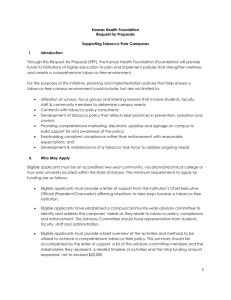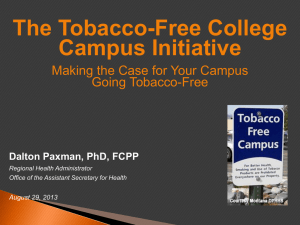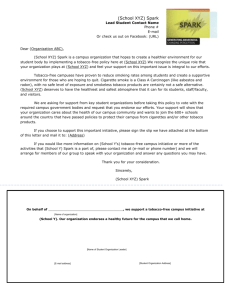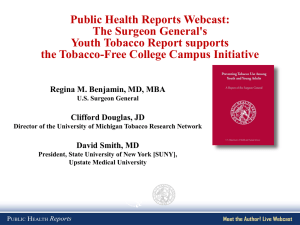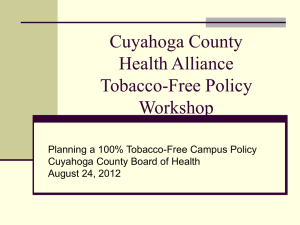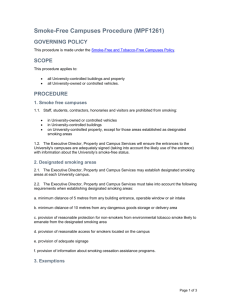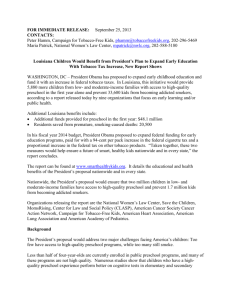Ten Years of Tobacco-Free Campus Policy
advertisement
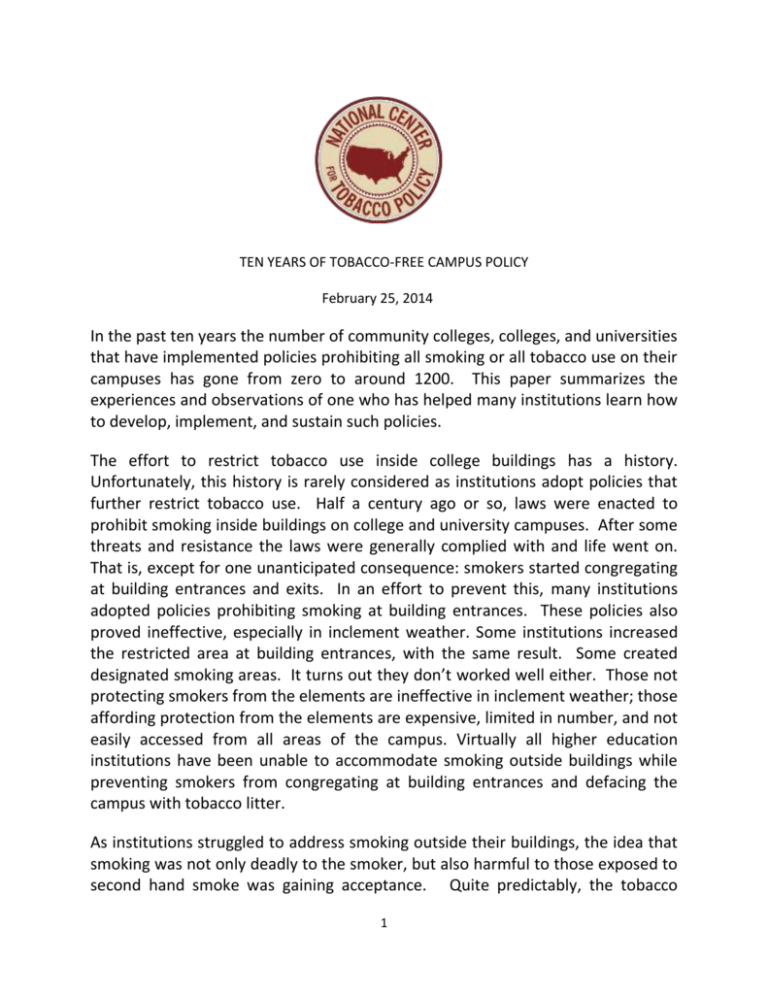
TEN YEARS OF TOBACCO-FREE CAMPUS POLICY February 25, 2014 In the past ten years the number of community colleges, colleges, and universities that have implemented policies prohibiting all smoking or all tobacco use on their campuses has gone from zero to around 1200. This paper summarizes the experiences and observations of one who has helped many institutions learn how to develop, implement, and sustain such policies. The effort to restrict tobacco use inside college buildings has a history. Unfortunately, this history is rarely considered as institutions adopt policies that further restrict tobacco use. Half a century ago or so, laws were enacted to prohibit smoking inside buildings on college and university campuses. After some threats and resistance the laws were generally complied with and life went on. That is, except for one unanticipated consequence: smokers started congregating at building entrances and exits. In an effort to prevent this, many institutions adopted policies prohibiting smoking at building entrances. These policies also proved ineffective, especially in inclement weather. Some institutions increased the restricted area at building entrances, with the same result. Some created designated smoking areas. It turns out they don’t worked well either. Those not protecting smokers from the elements are ineffective in inclement weather; those affording protection from the elements are expensive, limited in number, and not easily accessed from all areas of the campus. Virtually all higher education institutions have been unable to accommodate smoking outside buildings while preventing smokers from congregating at building entrances and defacing the campus with tobacco litter. As institutions struggled to address smoking outside their buildings, the idea that smoking was not only deadly to the smoker, but also harmful to those exposed to second hand smoke was gaining acceptance. Quite predictably, the tobacco 1 industry began developing other modes of tobacco use. Many are not familiar with the myriad of tobacco products available today. Pipes, cigars, cigarillos, chewing tobacco, snuff, are widely known forms of tobacco use. But many don’t know about flavored cigarettes, flavored disposable strips, packets with flavored loose leaf tobacco, and other products. E-cigarettes and other forms of “vaping” (inhaling of vapor from products or devices) are rapidly gaining popularity. And what is Hookah? The increase in use of these, often unregulated, smokeless tobacco products is creating problems for organizations with policies prohibiting smoking or tobacco use both indoors and in open spaces. Although knowledge about tobacco products and their use is limited, awareness about how, where, and under what conditions tobacco used in these products is grown and harvested, is even greater. The predatory practice of using tobacco planted and harvested by poor children in third world countries is virtually unknown. Many on college campuses are sensitive to social justice issues surrounding tobacco production and use, once they know the details. But who talks about social justice when a tobacco-free or smoke-free campus policy is being considered? There are other questions institutions often fail to ask as they consider revising tobacco policies. These include: what is the depth of knowledge about tobacco use and related issues on our campus; are their opportunities for collaboration with other interests, like sustainability and social justice; is use of smokeless tobacco inside buildings, or in subcultures such as rodeo and baseball evident? There are many questions that need to be answered in the process of deciding the right tobacco policy. A list of twenty is provided at the end of this monograph. For a myriad of reasons, growing numbers of faculty, staff, and students, on community college, college, and university campuses have concluded the best policy for their institution is to prohibit all tobacco use. Over the past ten years, we have developed and refined an approach that creates culture change to support tobacco-free campus policies. While no tobacco policy achieves perfect compliance, our unique approach works better than any we have seen. The reason is simple. From the start our objective has been to achieve compliance not just get a policy adopted. 2 From our experience, restriction on tobacco use occurs either by force of law or policy that penalizes noncompliance, or by policy, usually without penalizing noncompliance. Both approaches have failed to achieve compliance on college and hospital campuses. One is an unfunded mandate usually with no clear method of enforcement; the other is often quickly adopted, poorly communicated, and unenforceable. Both lack the culture change necessary to achieve self-enforcement. The most well intended policy, if implemented incorrectly, will fail. What does it say about an organization when it ignores noncompliance with a policy? What are students learning about violating rules in the world they are being prepared to enter and succeed? Surely, teaching disregard for policies is contrary to the purposes of higher education. Fortunately, there is a third option. It is counter-intuitive, time consuming, and more difficult. This is the approach we’ve developed and honed over the past decade. It is based on creating culture change to support a tobacco-free campus policy. It requires education and time. A year after Ozarks Technical Community College became one of the first higher education institutions in the US to implement a tobacco-free campus policy; the Center of Excellence for Tobacco-Free Campus Policy was created. Its purpose was to collect and share best practices in open space tobacco policy. In 2010, the National Center for Tobacco Policy, an independent, nonprofit organization was created to continue the work OTC’s Center of Excellence for Tobacco-Free Campus Policy. These organizations have helped thousands of administrators, faculty, staff, students, health policy advocates, and others learn how to develop, implement, and sustain tobacco-free campus policies that work. Over the past ten years through presentations at professional association conferences, workshops, webinar’s, emails, phone calls, and on-campus consultations we have shared our unique approach to tobacco policy. To date, on campus consultations have been conducted at seventy nine higher education institutions and hospitals. Appendix “A” lists these organizations. As the experience of working with all types of institutions grew, common characteristics associated with efforts to make campuses either smoke-free or tobacco-free began to emerge. Here are some. Information about tobacco policies is hard to find. Policies tend to be adopted through a top down approach with little explanation. Many are implemented with little, if any, thought about achieving compliance and end up focused exclusively on smoking. Enforcement, if 3 it exists at all, is almost always assigned to the office responsible for campus security. Signage is often confusing, and ineffective. The anti-smoking narrative is interpreted as anti-smoker. There is confusion regarding what the policy is and why it exists. Misuse of the terms smoke-free and tobacco-free further complicates matters. These terms have different meanings, yet even those who know better often use them interchangeably. Expertise about creating tobacco policy on college and university campuses is limited at best. In most cases the only reason for developing a policy is assumed to be the health benefits of getting people to quit, or to prevent them from taking up, the use of tobacco. This rationale, though important, conflicts with growing disaffection at the loss of personal freedom and the tradition of college and university campuses being places that emphasize freedom, not restriction, of behavior. Thus, resistance to making campuses tobacco-free is widespread and not hard to understand. It is not unusual for hospitals or medical centers to be looked to for guidance in making a college or university campus tobacco-free. Many healthcare facilities, whether mandated by the state or adopted on their own, have smoke-free campus policies. It is interesting that the mandated approach to making higher education institution campuses tobacco-free, often favored by administrators and health policy advocates, has failed in hospitals and medical centers, especially in getting patients and visitors to comply. There is a difference between getting a policy adopted and making it work. Too many are preoccupied with the former, too few with the latter. That may work with a city ordinance but not a college or hospital policy. One reason for the lack of attention to achieving compliance, or enforcement, is those advocating tobacco-free campus policies are rarely responsible for making the policy work. This is because the advocacy groups that have helped produce tobacco ordinances or laws enacted at the local or state level, are not involved in enforcement. Once an ordinance or law is passed, making the policy work becomes the responsibility of law enforcement and/or health departments. Questions like how will compliance be achieved, who will be responsible for enforcement, and how will the process be evaluated, are crucial to the success of the policy. Another issue directly related to the lack of will to achieve compliance with a smoke-free or tobacco-free campus policy is fear of negative consequences such as loss of enrollment, employee turnover, bad public relations, and so on. Anxiety 4 about these outcomes, though unjustified, causes many institutions to shy away from enforcing a policy. Hard evidence of the impact of tobacco-free or smokefree campus policy, good or bad, is difficult to find. As of this writing we are not aware of any institution rescinding a smoke-free or tobacco-free campus policy. We do not know of any institution that has experienced an enrollment decline after a smoke-free or tobacco-free campus policy went into effect. In fact, there is anecdotal evidence that enrollments have increased. Also, many report that parents of students are generally supportive of such policies. As previously stated, attempts to prohibit smoking outside building entrances and exits have been unsuccessful. Typically, institutional tobacco policies are implemented as soon as the decision to adopt is made. At OTC, we decided to seek Board approval for the policy but not have it go into effect for over three years. While unprecedented, this turned out to be one of the most important factors in the success of the tobacco-free campus policy. By allowing that much time, we avoided immediate pushback from students and could work on gaining the support of employees. Students knew they would be gone by the time the policy went into effect, thus negative reaction from them was minimized. After a year or more of educating faculty and staff we turned our attention to students. Taking time to educate, build support, and seek compliance among employees, helps create the culture change necessary to make the policy work for students. Many institutions try to drive the policy through student support. Whether employee or student, some oppose, some favor, and a lot are unsure about making their campus tobacco-free. We sought to gain the support of those who were unsure. To do so, the rationale for the policy was crucial. What rationale would get the support of students and employees who were unsure about such a policy? Respect for others and the environment remains the most effective rationale for making a campus tobacco-free we have found. Remember, it is one thing to make a campus tobacco-free out of respect for others and the environment, quite another to try to force tobacco users to quit. The health benefit of helping those who want to quit is a powerful added advantage. How many policies can save lives? After the desired policy and its rationale are determined, it is important to decide the process that will be used. This process includes organization, information, timeline, communication, evaluation, and so on. We recommend at least eighteen months from beginning to adoption. We suggest presidential 5 appointment of an ad hoc committee or task force with a written charge including an initial reporting date. Composition of the committee should include all segments of the institution as well as the community. The approach to establishing the committee may vary but its work should be transparent. For example, summaries of meetings could be streamed on the tobacco policy web page. A web page is crucial to communication. Taking time to determine and implement a tobacco policy creates a sense of inevitability that erodes resistance. It provides opportunity to identify potential problems and their solutions. Many adopt a policy before figuring out what to do about impact on neighbors, knowing how the policy applies on non-vacated streets, deciding what to do in leased space, addressing impact on those renting space, deciding what to do about tobacco use in parked vehicles, etc. If an institution takes time to consider what the policy should be, developes information to achieve and sustain compliance; devises a method to evaluate and adjust the process, it will have a good chance to make the policy succeed, at least initially. Success of the policy over time will require a continuing commitment to educate and seek compliance. It is particularly difficult to get people to continue the hard work, after the policy goes into effect. Absent an ongoing commitment of the entire institution to support the policy, it will likely fail. In 2003, OTC was one of the first higher education institutions to make its campus tobacco-free. Since then hundreds of institutions have been taught how to develop, implement, and sustain similar policies using the approach developed at OTC. This approach is based on achieving culture change to produce compliance (self-enforcement). Along the way we have found the predicate for making open spaces tobacco-free based on “respect for others and the environment” works best not only for a tobacco-free campus policy but for other issues as disparate as date rape and academic dishonesty that are plaguing higher education institutions. A tobacco-free campus policy based on respect for others and the environment can benefit a higher education institution or hospital far beyond eliminating tobacco use on its property. Twenty questions to consider as an institution decides on the best tobacco policy: 1) What is our current tobacco policy and how is it working? 6 2) What is happening with tobacco use policies locally, nationally, and internationally? 3) Why would we change our current policy? 4) What should our new policy be? 5) Why should we adopt the new policy? 6) How will we define success of the new policy? 7) How will we adopt, implement and achieving success of the new policy? 8) How will we obtain the support of employees, and students? 9) What is our individual responsibility in making the policy work? 10) What is a reasonable timeline for implementing a new tobacco policy? 11) What information about the policy is important? 12) How will this information be disseminated? 13) How will the policy be evaluated for effectiveness? 14) What about the perceived right of a person of age to use tobacco? 15) Will our enrollment, or retention of employees, be impacted by the new policy? 16) Do employees, students, have a responsibility to comply with the institution’s policies? 17) If so, how is this responsibility communicated? 18) What is an appropriate budget for the tobacco policy process? 19) What can we learn about tobacco policy from other institutions? 20) Is there a role for those outside our institution in the tobacco policy process? Questions or comments about this monograph and related matters may be directed via email to: ty@tobaccofreenow.com, or via telephone to: 417.773.4262. Ty Patterson, Executive Director, National Center for Tobacco Policy, www.tobaccofreenow.org Appendix A-List of organizations provided on campus consultation services 2005-2014 1. Alaska Tobacco-Free Campaign, Anchorage, Alaska 2. Ashland Community College, Ashland, Kentucky 3. Bemidji State University, Bemidji, Minnesota 4. Borough of Manhattan Community College, Manhattan, New York 5. Bronx Community College, Bronx, New York 6. Brooklyn College, Brooklyn, New York 7. Buffalo State College, Buffalo, New York* 8. Butler Community College, Eldorado, Kansas* 7 9. City University of New York (CUNY), Central Administration, Manhattan, New York 10. Cayuga Community College, Auburn, New York 11. Clackamas Community College, Oregon City, Oregon 12. Colgate University, Hamilton, New York 13. College of Staten Island, Staten Island, New York* 14. Culinary Institute of America, Hyde Park, New York 15. Danville Community College, Danville, Illinois* 16. Daemen College, Amherst, New York 17. Des Moines Area Community College, Des Moines, Iowa 18. Drury University, Springfield, Missouri* 19. Farmingdale State College, Farmingdale, New York 20. Hawkeye Community College, Waterloo, Iowa 21. Harlem Hospital, Harlem, New York 22. Hostos Community College, Bronx, New York 23. Hunter College, Manhattan, New York 24. Ivy Tech Community College, Lafayette, Indiana 25. Jamaica Hospital, Queens, New York 26. John Jay College of Criminal Justice, Manhattan, New York 27. Kansas State Tobacco-Free Campaign, Wichita, Kansas 28. Kingsborough Community College, Brooklyn, New York 29. La Guardia Community College, Queens, New York 30. Lane Community College, Eugene, Oregon 31. Lansing Community College, Lansing, Michigan 32. Lehman College, Bronx, New York 33. Lemoyne College, Syracuse, New York 34. Lincoln University, Jefferson City, Missouri 35. Louisiana State University, Baton Rouge, Louisiana 36. Maimonides Hospital, Brooklyn, New York 37. Marshall Medical Centers, Boaz and Gunter, Alabama 38. Medgar Evers College, Brooklyn, New York 39. Metropolitan Hospital, Manhattan, New York, 40. Mid-Plains Community College, North Platte, Nebraska 41. Mineral Area College, Farmington, Missouri* 42. Missouri Western State University, St. Joseph, Missouri 43. Monroe Community College, Rochester, New York 44. Nebraska State Tobacco-Free Campaign, Lincoln, Nebraska 45. New Community College, Manhattan, New York 46. New York City Tobacco-Free Hospitals Campaign, New York* 47. Niagara University, Niagara Falls, New York 48. North Dakota State College of Science, Wahpeton, North Dakota 49. North Dakota State University, Fargo, North Dakota 50. North West Arkansas Community College, Bentonville, Arkansas 51. Northern Kentucky University, Highland Heights, Kentucky 52. Northwestern Michigan College, Traverse City, Michigan* 53. Oklahoma State University of Science and Technology, Okmulgee, Oklahoma 8 54. Onondaga Community College, Syracuse, New York 55. Pittsburg State University, Pittsburg, Kansas* 56. Portland Community College, Portland, Oregon 57. Queensborough Community College, Bayside, New York 58. River Parishes Community College, Sorrento, Louisiana 59. Rogue Community College, Medford, Oregon 60. Seattle Community College, Seattle, Washington 61. Snead State College, Boaz, Alabama 62. Southwest Oregon Community College, Coos Bay, Oregon 63. Stanly College, Albemarle, North Carolina 64. St Louis Community CollegeMeramec, St Louis, Missouri 65. State University at Albany, Albany, New York* 66. State University at Buffalo, Buffalo, New York 67. State University of New YorkCanton, Canton, New York 68. State University of New York (SUNY) Central Administration, Albany, New York* 69. University of Alaska-Anchorage, Anchorage, Alaska 70. University of Arkansas, Fayetteville, Arkansas* 71. University of Central Missouri, Warrensburg, Missouri 72. University of Central Oklahoma, Edmond, Oklahoma 73. University of Minnesota-Duluth, Duluth, Minnesota 74. University of Rochester, Rochester, New York 75. Villa Maria College, Cheektowaga, New York 76. Weber State University, Ogden, Utah 77. Westchester Community College, Valhalla, New York* 78. Westminster College, Fulton, Missouri* 79. York College, Queens, New York *Denotes multiple visits. 9
